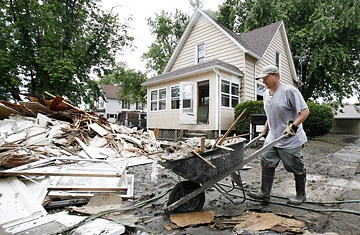
Chuck Morrison cleans out a flood-damaged home in Oakville, Iowa. Nearly every building in the small southeast Iowa town was affected during the June flood, leaving many residents to ponder the future of the town
The floods that decimated the Midwest earlier this summer were bad, but the devastation was made worse by the long-standing American tradition of homeowners not preparing financially for such a disaster. According to FEMA, fewer than 10% of people in high-risk areas in the Midwest have flood insurance.
That, however, may be about to change. In a historic overhaul of the National Flood Insurance Program, Congress may require anyone who lives behind a levee to get flood insurance. That could mean millions of people would have to spend about $300 to $900 more a year on insurance — and might not be left destitute after a flood.
But the debate is at a precarious point. The Senate has passed a version of the bill that requires the new insurance mandate. But the House version only requires a study of such a change. The differences have to be worked out in a conference committee. "Probably the whole country should have flood insurance," says one congressional aide who is knowledgeable about the bills. "But we're concerned about what economic impact it's going to have on the program or the communities affected before we start."
On July 15, in a bid to urge Congress to do the right thing, 242 natural-hazards experts sent a letter to Congress supporting the Senate version. "Every level of society has a role to play in reducing losses," the letter asserted. After Hurricane Katrina and the Midwest floods, "the suffering of thousands of home and business owners was compounded because they lacked flood insurance — not because it was unavailable, but because they did not purchase it."
All Americans are at risk of flooding, according to the National Flood Insurance Program. And regular homeowners' insurance does not generally cover flood damage. Despite that, the only people currently required to get flood insurance are those who have federally backed homeowner loans and live in certain high-risk flood zones. (Which is sort of like requiring only 18-year-old males who drive red Ferraris to get car insurance.)
Even in high-risk areas, many people still do not have insurance — either because their bank didn't make them get (or keep) it or because they don't have federally backed loans. In some cases, communities, worried about home values, have successfully convinced the government that the area is not at risk. Some of those places flooded this year, leaving residents to wonder why their local leaders hadn't warned them. Today, there are about 5 million flood insurance policies in place in the U.S. Butch Kinerney, spokesman for FEMA, calls the flood insurance rate "abysmally low."
Part of the problem is that many millions of Americans do not even know that they are at a significant risk of flooding, says Gerald Galloway, an engineering professor at the University of Maryland who led the White House study of the 1993 Mississippi flood as an Army brigadier general. People who live behind levees are especially at risk. They tend to overestimate the strength of the levees — and underestimate the ways that development dramatically lowers the protection level over time. What was once a 100-year flood — a term that itself is misleading — now in many places amounts to a 50-year flood.
"I built or upgraded some of the levees on the lower Mississippi. I know they're very good," says Galloway, who signed the letter to Congress. "But I can't guarantee you there is not going to be a problem." (To get an instant estimate of your own flood risk, plug your address in to the risk-profile box at floodsmart.gov.) "We need to share the responsibility. I'm not sure [Congress] does someone a favor when it says, We're protecting you by not making you buy flood insurance."
Many people also don't realize that they won't qualify for most federal disaster aid if their community didn't participate in the National Flood Insurance Program before the storm. So if people are quietly counting on the Federal Government to bail them out afterward, they will be disappointed.
In the debate on Capitol Hill this summer, there are signs that the cycle of doom may continue. Many homeowners, business people and local officials oppose the new insurance requirement, fearing the effects on development (though that development of coastal and other flood-prone areas is a big part of the problem) and on already financially strained families. "When people are having trouble making their mortgage payment, it's hard to consider having an additional expense for flood insurance that you think you won't soon need," says Steve Ellis, vice president of Taxpayers for Common Sense, which supports the new requirement. "But what happened in the Midwest this year really hammered this point home. Many of the people who were affected were exactly the people this provision would target."
Senior writer Amanda Ripley is the author of The Unthinkable: Who Survives When Disaster Strikes — and Why, a new book about human behavior in disasters
